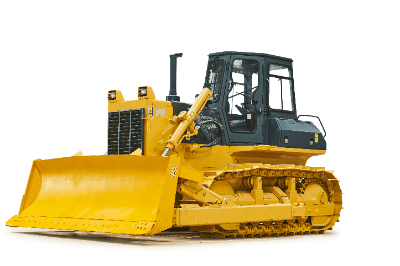What Is a Bulldozer?

A bulldozer is an earthmoving machine used for excavation, embankment, leveling, snow removal, and various civil engineering tasks.
Bulldozers exert significant force to push and move large volumes of soil, rocks, making them indispensable on construction sites. By reducing the gear on the rotating side connected to the engine and increasing the gear that turns the wheels, bulldozers generate substantial power.
The origin of the term “bulldozer” has various theories. One suggests that in the United States, the appearance of bulldozers led to bulls becoming so idle (doze) that they were named “Bulldozer.” However, since horses and mules were more commonly used than bulls, a prevailing theory suggests that it evolved from the slang “Bull’s dose,” meaning “to forcefully push forward.”
Uses of Bulldozer
Bulldozers are used in civil engineering, dam construction, land development, and more. Due to their frequent use in large-scale projects like bamboo forest clearance, there is a higher demand in developing countries where land development is still in progress compared to advanced nations.
Moreover, bulldozers come in various types, including amphibious models for construction in places inaccessible to dredging ships and remote-controlled bulldozers for hazardous disaster sites. Recently, ICT bulldozers equipped with GPS and 3D design support operators with automatic blade control, promising further improvement in operational efficiency.
Features of Bulldozer
One prominent feature of bulldozers is their blade. Applying weight to the front end of the blade allows for excavation, earthmoving, and leveling. The blade is attachment-style, allowing it to be changed based on the intended use.
Another notable feature is the crawler. The crawler consists of metal or rubber-like long plates connected around the drive wheel, enabling the bulldozer to travel even on rough terrain.
Bulldozers are categorized as dry-land and wetland types, each with different crawler shapes. Wetland models have wider crawlers to lower ground pressure, and they use special triangular-shaped shoes to facilitate construction on soft ground.
Types of Bulldozers
There are several types of bulldozers based on the blade type and additional equipment called a ripper.
1. Classification by Blade
Straight Dozer
The blade is attached perpendicular to the centerline of the body. It has substantial excavation force and is used for general soil excavation, compaction, and soft rock excavation.
U-Blade
Both sides of the blade are curved forward, allowing for the transport of a large amount of soil.
Angle or Power Angle Dozer
Some bulldozers are equipped with features called angle or power angle. Angle dozers can attach blades at an angle to either side, while power angle dozers have hydraulic features that tilt the blade left or right. These can be used for a wide range of tasks such as excavation, backfilling, ditching, and leveling.
Rake Dozer
A type of attachment for bulldozers used in large-scale landscaping to remove large rocks.
Two-Way Dozer
Capable of both front pushing and pulling materials, often used for grain transport ships or for cargo handling inside ships.
2. Classification by Ripper
Multi-Shank Ripper
A standard ripper with three tines. The number of shanks can be adjusted based on the hardness of the bedrock.
Giant Ripper
A ripper with one long shank, suitable for deep digging.
Parallel Link Ripper
A ripper with one shank and a parallel link mechanism to maintain a constant penetration angle even with varying depths.
Hinge-Type Ripper
A simple and cost-effective ripper with a disadvantage of changing shank angles with penetration depth, making it less commonly used today.